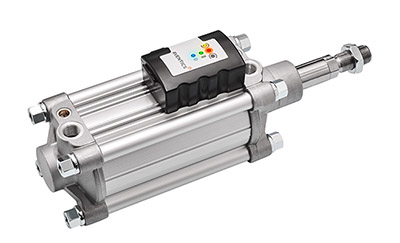 In the past, you often needed experience, a special touch, and a lot of patience to correctly adjust the cushioning for pneumatic cylinders. The new CAT (Cushioning Adjustment Tool) diagnostic tool assists the installer with an LED display and visualization in a smartphone app. Optimal adjustment of cushioning is important for trouble-free operation, quiet running, and high cycle frequencies in systems.
In the past, you often needed experience, a special touch, and a lot of patience to correctly adjust the cushioning for pneumatic cylinders. The new CAT (Cushioning Adjustment Tool) diagnostic tool assists the installer with an LED display and visualization in a smartphone app. Optimal adjustment of cushioning is important for trouble-free operation, quiet running, and high cycle frequencies in systems.
“Easier, faster, and more precise” are the words Abdelhakim Boulakhrif uses to concisely describe the advantages of CAT. The sensor expert at Aventics continues, “Thanks to visual support with the LED traffic light system, even a child could correctly adjust the cushioning.” The tool clearly shows the installer which way the cushioning needs to be adjusted. A smartphone app also visualizes the set cushioning characteristics and piston speed. This allows users to fully benefit from the excellent characteristics of Aventics cylinders in the system, as fine adjustment becomes a thing of the past.
The diagnostic tool is simply fixed to the cylinder. CAT detects if and how the cushioning setting must be changed by evaluating the position and speed of the piston using magnetic sensors. The device only measures 5.5 by 8.3 cm and can be removed once everything has been set correctly. An integrated battery that can be recharged via a micro USB connection supplies the power. The associated app is compatible with Android and iOS smartphones. CAT can be used to commission and check Aventics cylinder series PRA, CSL-RD, MNI, ICL, IST, TRB, and CCL. The Cushioning Adjustment Tool adds to Aventics’ wide range of engineering and assembly tools. Aventics’ push to digitalize pneumatics aims to reduce costs, increase system reliability, simplify machine designs, and boost life cycles.
Aventics
www.aventics.com
Filed Under: Pneumatic Tips